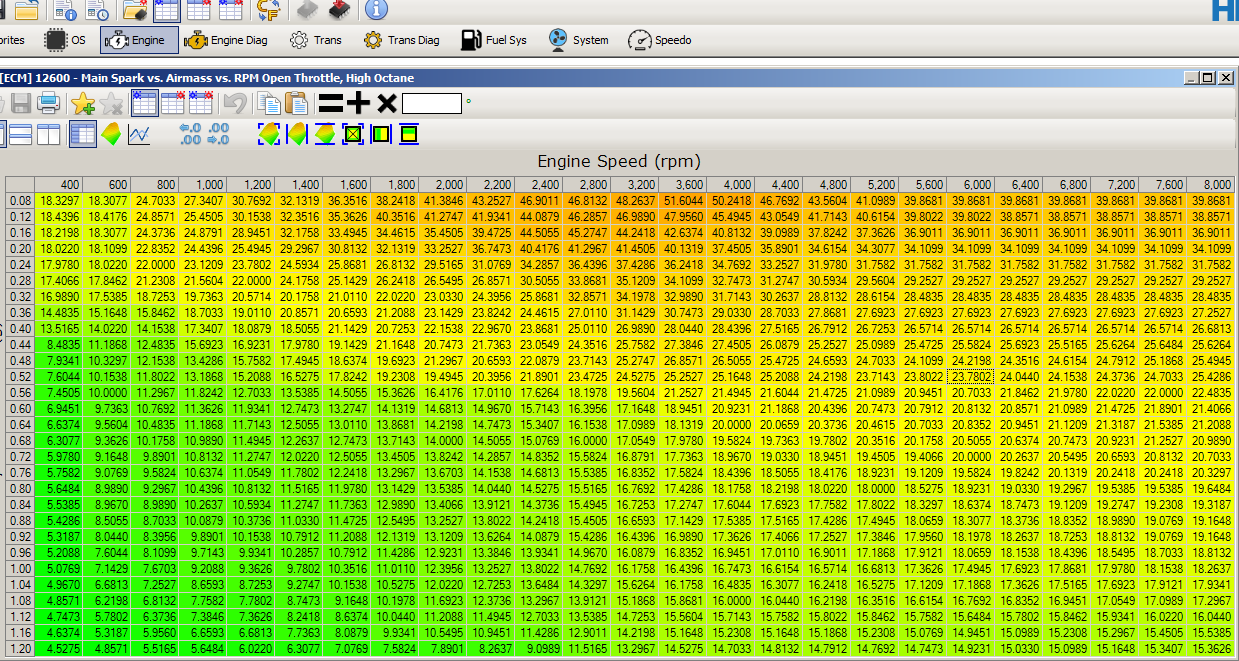why is there a low octane map on the left, and a high octane map on the right. Which map are you using? Did you realize you changed a different map? Or are you just showing me old vs new?
As far as timing, first you need to make sure there are no other maps involved. There are several ways to impact timing, under "base corrections" the "fuel", "iat", and "ect" maps for example all affect timing if they are used. Don't just assume the numbers in the high octane map are final for example.
Now on the the timing profile. Do you have experience with distributors? The timing curve should be somewhat similar with the caveat that around peak torque we usually soften it up a bit as you have attempted to do. However you really need a torque curve from a dynometer because many high performance engine often ride peak torque to redline or nearly so. So it can be difficult to tell just by the map how the torque is going to be affected by your timing inputs.
The only real issue I see with the curve is that there are too large of changes from one cell to the next after the 'distributor' goes 'all in'. Take a look at my pump gas timing curve for example.
Attachment 102197
at LOW rpm you must be very conservative with timing. When to go "all in" depends on the final gear ratio you will use at WOT for extended duration; In other words if you wanted to use overdrive gear from a very low RPM with to 200mph at full torque for a 2 mile race you will go 'all in' later than if the car is strictly 1/4 mile and never goes WOT in overdrive. Likewise if the vehicle is very heavy this is similar to using a numerically low gear ratio as it also slows the rate of engine acceleration. Another factor is compression ratio, the higher the compression the later you would push full timing in the RPM range. Fuel quality is also a factor, low octane fuels as 87 and 93 octane are much less tolerant of high timing values in general and this is exacerbated by low rpm due to a combination of low rate of change of engine rpm and the tendency of the fuel to react faster with high heat input of forced induction.
I recommend
from 2000rpm to 3000rpm I would move from say 10* to 12* only. Then from 3000rpm to 4400rpm move from 12 to 13.5*
from 4400 to peak torque move to 14*, then through peak torque back to 13.5 to 13.8 range, then if you exit peak torque by 5800rpm (mild cams or dropping boost) back to 14* pushing maybe 14.5 to 14.8* by redline. There should not be any values over 15* anywhere in the final row IMO. Not with your compression ratio anyways.
Then you would dynometer that and add 1.2 to 1.5* across the board (for a peak of say 15.5 to 16.3* total by redline (on 65 to 75% Alcohol) and re-check your torque curve with zero smoothing on a dynojet and compare. Anywhere it gains more than 5% torque (say from 400ft*lbs to 420ft*lbs or from 800 to 840) is a win and should be coupled to a drop in EGT , say 40 to 60*F perhaps even 80*F depending where the sensor is located (preferably pre-turbine on a turbo setup). Gains of less than 5% are negligible and you should remove the added timing because when the vehicle hits the actual road that extra timing, even if it gave extra power on the dyno, could damage the engine in real-street situations because of increased pressure.
E85 is very tolerant of high timing values and many run 18 or 20* in your situation, however not with that compression ratio so high. So don't be fooled when looking at low compression engines on E85 using 18 and 20* of timing, they are 9:1 its fine. But at 10:1 and 11:1 compression timing is not your friend. I would be surprised if that engine will want more than 13 or 14* total, if that.` Put it this way, If you can keep pulling out timing, lets say from 14 to 12 to 10* , and get a similar torque curve, and similar EGT, then that is a good thing, use the least amount of timing necessary.
As to EGT the number itself is irrelevant; every EGT sensor and placement will result with a different number. Instead, what we focus on is the difference from run to run. 1300*F this time and 1250*F next time for example. Or if the number sky rockets beyond 1400*F to say 1440 or 1550*F is a potentially dangerous situation. You must use common sense with temperature, if it seems too high it probably is. Metal can melt, materials will warp, valves can get too hot. 100% distilled water is the only thing that can really control EGT besides turning down the power so keep that in mind, it's better to reduce timing and use water injection than it is to advance timing to control EGT, even if it costs power, because the name of the game is engine longevity not peak power, unless you are racing for money or fame of course.
Advantage of iridium for forced induction engines is consistency and long life. It's the last thing I do to an engine after street tuning before hitting the dyno for the final dyno-tuning. I've just done it that way for 20 years on every forced induction engine, 2jz, sr20, rb26, etc... thought I'd mention it.




 Reply With Quote
Reply With Quote
